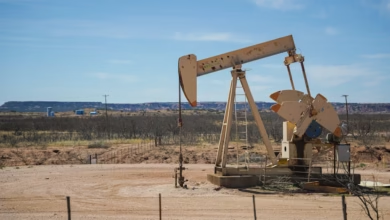Understanding Oil Reserves: A Comprehensive Guide to Proven, Probable, and Potential Resources in the Global Oil Market

The global oil market is a complex and ever-evolving landscape, shaped by a myriad of factors that influence oil prices and energy security. Understanding the distinctions between proven, probable, and potential oil reserves is crucial for anyone interested in oil investing or the broader implications of oil consumption. Proven reserves represent the crude oil that is economically recoverable, while probable reserves indicate oil that is likely to be extracted, albeit with less certainty. Potential reserves, on the other hand, offer a glimpse into future possibilities, highlighting the untapped resources waiting to be explored.
As we delve deeper into this topic, we will also explore the significant role of OPEC and the geopolitical dynamics that impact oil supply chains and market trends. The complexities of oil geopolitics can dramatically influence oil prices, making it essential for investors and policymakers to stay informed. Furthermore, the environmental impact of oil extraction, from offshore drilling to the exploration of alternatives like biofuels, is a pressing concern that cannot be overlooked. This article aims to provide a comprehensive overview of oil reserves worldwide, while also considering the implications of oil technologies, oil regulations, and the future of energy as we navigate the challenges of oil storage, transportation, and compliance within the context of an evolving energy landscape.
- 1. Understanding Oil Reserves: Proven, Probable, and Potential Resources in the Global Oil Market
- 2. The Role of OPEC and Geopolitics in Shaping Oil Prices and Supply Chains
- 3. Exploring the Environmental Impact of Oil Extraction: From Offshore Drilling to Oil Alternatives
1. Understanding Oil Reserves: Proven, Probable, and Potential Resources in the Global Oil Market
Understanding oil reserves is crucial for navigating the complexities of the global oil market. Oil reserves are classified into three main categories: proven, probable, and potential resources. Each classification reflects the level of certainty regarding the recoverability of crude oil from a specific location, influencing oil prices and market dynamics.
Proven reserves are quantities of crude oil that geological and engineering data demonstrate with high confidence can be extracted commercially. These reserves play a significant role in determining energy security for countries and are often the focus of oil exploration efforts. Proven reserves are critical for oil companies and investors as they underpin the financial viability of oil refining and production operations.
Probable reserves, on the other hand, are those that are less certain but have a reasonable chance of being recovered based on geological data and current extraction technologies. The distinction between proven and probable reserves is essential for assessing oil market trends and investment opportunities. Investors often look at both proven and probable reserves to gauge the potential for future oil production and, consequently, the stability of oil prices.
Potential resources represent the estimated quantities of crude oil that may be discovered in the future through exploration efforts. These reserves often include unproven reserves found in less explored regions such as offshore drilling sites and shale oil formations. The potential for discovering new oil reserves can influence oil geopolitics, as countries seek to secure their energy supplies amid shifting global demand.
The environmental impact of oil extraction and consumption is a growing concern, prompting discussions around oil alternatives such as biofuels and natural gas. As the world moves towards more sustainable energy sources, the balance of oil reserves and their exploitation will play a vital role in shaping future energy policies and investment strategies.
Understanding these various categories of oil reserves not only informs oil field services and exploration strategies but also impacts oil transportation, storage, and supply chains. As countries navigate oil regulation and compliance, the clarity around proven, probable, and potential reserves becomes increasingly important for maintaining competitiveness in the global oil trade. Furthermore, developments in oil technologies and advancements in offshore drilling can unlock new reserves, further influencing the landscape of oil investing and price hedging strategies.
As the energy sector evolves, the interplay between oil reserves and alternative energy sources will become critical in ensuring a balanced approach to energy consumption and environmental stewardship.
2. The Role of OPEC and Geopolitics in Shaping Oil Prices and Supply Chains
The oil market is heavily influenced by the Organization of the Petroleum Exporting Countries (OPEC) and the complex interplay of geopolitics that shapes oil prices and supply chains. OPEC, which consists of major oil-producing nations, plays a crucial role in regulating crude oil production to stabilize or manipulate global oil prices. By coordinating output levels among its members, OPEC seeks to maintain a balance between supply and demand, which ultimately affects oil prices worldwide.
Geopolitical events, such as conflicts in oil-rich regions or changes in government policies, can lead to fluctuations in oil market trends. For instance, tensions in the Middle East often prompt fears of supply disruptions, causing spikes in crude oil prices. Additionally, the rise of shale oil production in the United States has altered the landscape of the global oil trade, challenging OPEC’s traditional influence and creating a more competitive environment.
The dynamics of oil supply chains are also shaped by geopolitical relationships. Countries that maintain stable relations with oil-producing nations often secure favorable terms for oil transportation and storage, ensuring energy security for their economies. Conversely, nations facing political instability may struggle with oil compliance and regulation, impacting their ability to manage oil exploration and production effectively.
Furthermore, the environmental impact of oil extraction and refining is becoming an increasingly critical factor in oil geopolitics. As the global community shifts toward oil alternatives and biofuels, the demand for traditional oil sources, including oil sands and offshore drilling, faces scrutiny. This transition not only affects oil consumption patterns but also influences investments in oil technologies and oil field services, as companies seek to adapt to changing regulations and consumer preferences.
In summary, the role of OPEC and the intricacies of oil geopolitics are pivotal in shaping the landscape of oil prices and supply chains. Understanding these elements is essential for anyone involved in oil investing or related sectors, particularly as the world grapples with the dual challenges of meeting energy needs and addressing the environmental impact of oil.
3. Exploring the Environmental Impact of Oil Extraction: From Offshore Drilling to Oil Alternatives
The environmental impact of oil extraction is a pressing concern that has garnered significant attention in recent years. As the world continues to rely heavily on crude oil for energy, understanding the implications of both traditional extraction methods and emerging oil alternatives is crucial.
Offshore drilling, while a significant contributor to the global oil trade, poses numerous environmental risks. The potential for oil spills during extraction, as well as the disruption to marine ecosystems, highlights the challenges of balancing energy needs with environmental protection. The oil market trends indicate a growing scrutiny of offshore operations, particularly in light of incidents that have led to devastating ecological consequences. As oil prices fluctuate, the viability of offshore drilling becomes more contentious, compelling governments and companies to consider stricter oil regulation and compliance measures.
Onshore, the extraction of shale oil and oil sands has also raised concerns about land degradation, water usage, and air pollution. The process of extracting these resources demands advanced oil technologies and significant energy consumption, which can further exacerbate environmental issues. The extraction and refining processes contribute to greenhouse gas emissions, prompting discussions about energy security and the need for more sustainable practices within the oil supply chains.
As the world seeks to reduce its dependence on fossil fuels, oil alternatives such as biofuels are gaining traction. These renewable energy sources promise to mitigate some of the adverse environmental impacts associated with traditional oil consumption. However, the transition to biofuels and other alternatives must be managed carefully to avoid unintended consequences, such as land use changes that could threaten food security.
Additionally, the geopolitical landscape surrounding oil is influenced by environmental considerations. OPEC and other oil-producing nations are increasingly aware of the need to balance economic interests with environmental stewardship. Oil price hedging strategies are being reassessed in light of potential regulatory changes aimed at reducing carbon footprints and promoting cleaner energy sources.
In summary, exploring the environmental impact of oil extraction reveals a complex interplay between energy demands and ecological preservation. As the global community navigates these challenges, it is imperative to prioritize sustainable practices and innovations in oil field services while considering the broader implications of oil geopolitics and environmental health.
In conclusion, understanding the various classifications of oil reserves—proven, probable, and potential—provides a crucial foundation for navigating the complexities of the global oil market. As we have explored, the role of OPEC and the broader geopolitical landscape significantly influence oil prices and supply chains, affecting everything from oil transportation to the dynamics of oil investing. Additionally, the environmental impact of oil extraction methods, including offshore drilling and shale oil production, raises critical questions about energy security and sustainability.
As the world grapples with the need for cleaner energy alternatives, the shift towards biofuels and other oil alternatives is becoming increasingly relevant. The ongoing developments in oil technologies, coupled with shifts in oil consumption patterns, will undoubtedly shape future oil market trends and oil price hedging strategies.
For stakeholders in the global oil trade, from oil field services to downstream oil operations and petrochemicals, understanding these elements is essential for compliance and strategic planning. As we look ahead, the balance between ensuring energy security and addressing the environmental impact of oil will be paramount in shaping the future of oil regulation and exploration. Staying informed about these factors will be vital for anyone involved in the oil industry, ensuring they are prepared for the challenges and opportunities that lie ahead.
References:
– (Include relevant references based on the content of the article)





